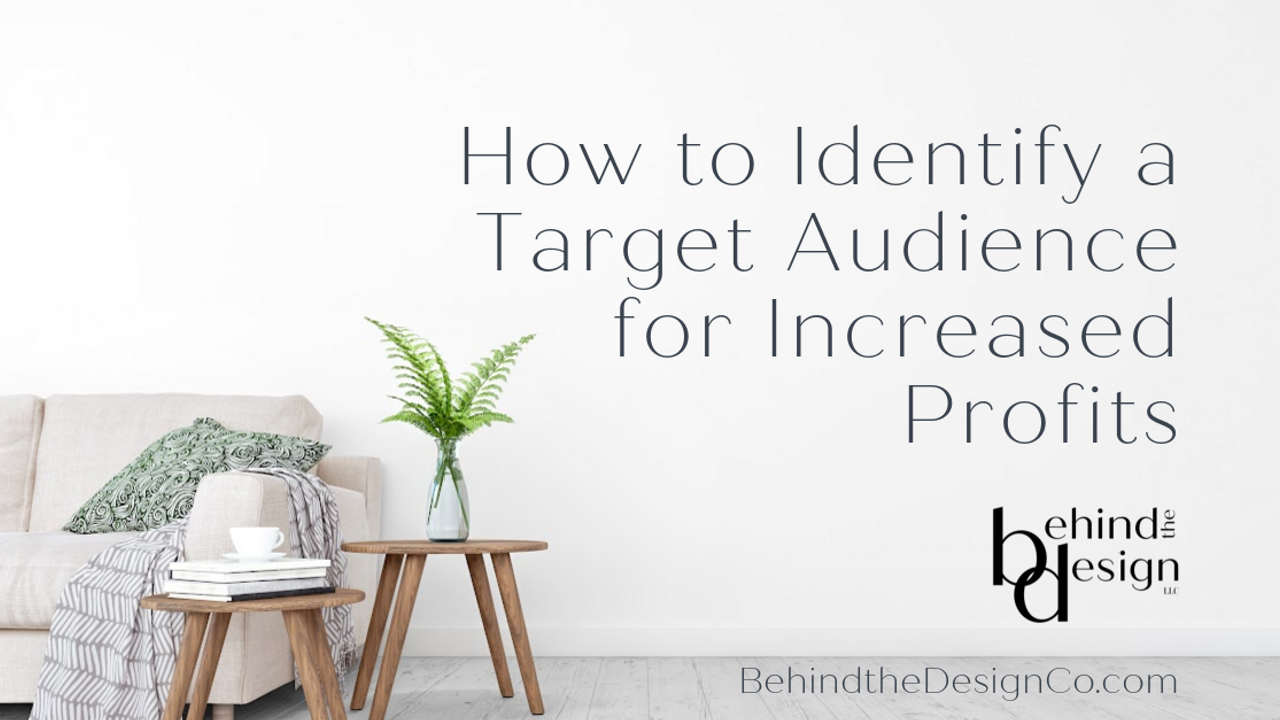How to Identify a Target Audience for Increased Profitability
Sep 16, 2021
Identifying your target audience isn’t always easy. Yet, most marketing podcasts and courses tell you to start with identify your target audience. Most go on to say that you need to know your audience thoroughly. These marketing sources are completely correct; however, what happens when you don’t have the foggiest idea of how to go about identifying your audience, let alone understanding them. In this article, we will discuss key indicators that you need to consider when choosing a target audience.
About a year ago, an interior design student approached me after class asking for marketing advice. She was working for the custom home builder, and they were expanding their business to include high-end hardware and fixtures. She wanted to know how she could market the new product lines.
My first question was, who are your potential customers? Her response was anyone. Well, that isn’t the case. A homeowner who owns a $200,000 home versus a two-million-dollar home is much different.
The $200k homeowner will most likely buy their hardware and fixtures at a big box store. That person is looking for value over status. Whereas someone who owns a two-million-dollar home isn’t necessarily concerned with price, they may be looking for statement pieces that solidify their status in their social circle.
When the student and I talked about specifics, she soon realized that her audience wasn’t everyone. It was most likely homeowners with a home valuing over a million. So even though the product line might be unbelievably beautiful, the product wasn’t priced for everyone.
Beyond Target Market Demographics
This same scenario applies to an interior design business. Not everyone is a viable customer. Most interior designers have identified that their primary customer needs to afford the service, therefore, needs an above-average income. That is a demographic trait.
We look at our audience for different demographic indicators, such as age, profession, gender, education, marital status, and income levels, to name a few. Also included in demographics is the neighborhood they live in and even the car they drive. So I bet you probably have a good indication of the demographics of your target audience based on your current clients.
However, it is important to look beyond demographics toward psychographics. These represent things like feelings, social status, beliefs, drivers, personality traits, and so forth. It is equally important to take into considerations psychographics. For instance, you may see a married couple with an income over $250,000 annually living in a million-dollar neighborhood as a potential client.
However, if you dig into the psychographics, you may find that this couple is DIYers. Their attitude toward working on their home themselves is rewarding, and they know the work will be done to their standards. Therefore, this couple would most likely not be in your target audience.
Understanding how people think, what they believe in, what drives their decisions, and how they act takes you beyond just demographics. You may also need to know where they socialize, shop, and what restaurant they visit. Other good information is organizations they support through time and money.
Anytime you can make a personal connection with someone, it will help drive your business growth.
Recognizing this early on saved her time and money and helped her develop the messaging that would resonate with the high-end market.
Narrowing Your Audience Size
Another important part to consider is the size of your target audience. It is too easy for us to think we can be all to everyone. This logic will get you into trouble and will reduce profitability.
In Seth Godin’s book “This is Marketing,” he discusses the smallest viable market. (If you haven’t read this book, I highly recommend it.) Seth suggests that we reduce our target market size considerably and focus our efforts on serving that target audience to the highest level of service. In this book, he goes into how marketing should serve the customer rather than sell the customer.
I believe reducing your audience size is a scary proposition for most interior designers. The reason this sounds scary to you is because you are worried that if you only target a small portion of people, then you are, in turn, reducing your opportunities to make money. This isn’t actually true, though it feels that way.
By better targeting the “right” customer, you can actually increase your profits substantially, as well as your customers’ satisfaction level. An increase in customer satisfaction will increase referrals and therefore increasing profits.
Related Article: “8 Steps to Improve your LinkedIn Profile for Lead Generation in Your Design Business”
Although you want to add everyone under the sun as a potential client, it is not a wise business strategy. By targeting a larger audience, you are essentially diluting your marketing message, wastes time and energy, and potentially compromises the service you offer. The solution is to narrow your focus to the smallest viable audience and really get to know who they are and what drives them to purchase.
Analyze Current Customer Base
How do we get to this core audience that will supposedly grow your revenue? Start with analyzing your current and past clients. First, write down all customers from the past two to five years. Next, pull out demographics for each client, such as marital status, age, income, profession, etc. Then list all services purchased or performed as well as revenue generated and profit. Remember, revenue and profit are not the same.
Hopefully, you are starting to see trends as you record the data. Next, think about and list things you know about the client, such as organizations they support, social beliefs, overall attitude, and so forth.
Finally, the last column will include how they were to work with you through the design process, including how they treated your team, how many over reactional calls you received, and how many change orders they made, costing you more time and money.
I add this last column in because it is important for your own sanity. One, you want to work with clients that propel your business, treat your team with respect, and are fun to serve. No one wants to work with a crabby, overbearing client that is never satisfied.
Now, take a deep dive into the information you collected. What stands out to you? What characteristics and traits do the clients that were a pleasure to serve and profitable have in common? Those are the key indicators for your target audience. With this analysis, you can start developing a map of your target audience. You can now do additional research on this audience to help you with marketing and creating the message that resonates with them rather than everyone.
Need help growing your design business?
Want more educational and free information on marketing and business strategy, professional and employee development, and software tutorials? Sign up for our free monthly newsletter email and get great information designed to help you grow your business, your team, and your skills.
Tags: how to determine a target market, interior design business, what is a target market, demographics, women entrepreneurs, business tips for interior designers, behind the design, women in design, interior design business, marketing 101, marketing tips for interior designers, marketing strategy, business design goals
Sign Up for Our Monthly Newsletter
Get helpful career, business, and design tips right in your inbox each month.
At Behind the Design, we are committed to building a stronger design community by reimagining education, training, and support for interior designers. Through our various software training options, educational articles covering everything from leadership to marketing, and soon Continuing educational courses, we are committed to helping you. Join our newsletter to get the latest education and training updates.









